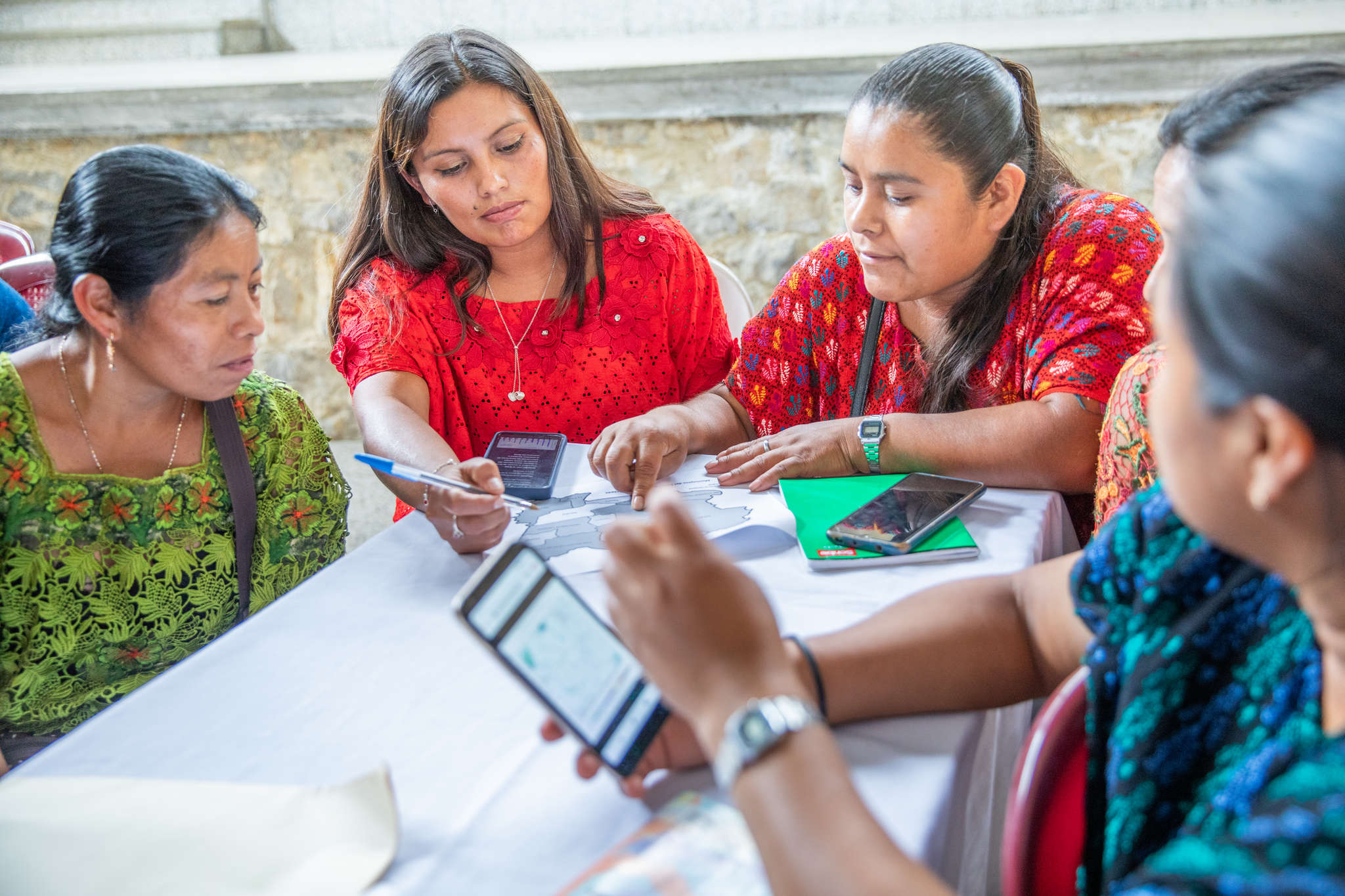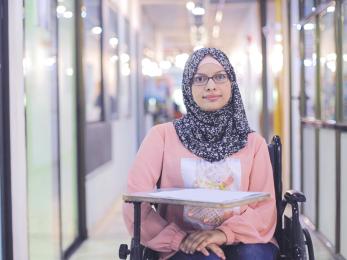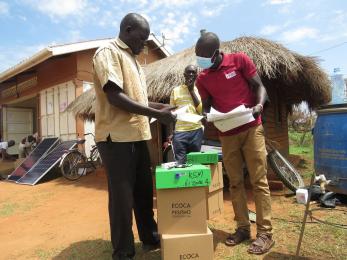Field testing virtual reality mindfulness and relaxation therapy

Over 6 million people in Iraq have been displaced due to violent conflict since 2014, with only half of them being able to return home. According to UNICEF, 3.2 million children currently lack access to education. Generations of children have only known an environment marked by conflict and unrest. Growing up surrounded by violence and instability can cause severe trauma, chronic stress, and Post Traumatic Stress syndrome (PTSD), with long-term impact on children’s lives.
Since 2003, Mercy Corps has been working in Iraq to support both social and physical reconstruction. In 2015, we began a program to help young people in Iraq cope with trauma by creating physical safe spaces where they can learn, play, and access therapists.
Virtual Reality as a therapeutic tool
The use of Virtual Reality (VR) as a tool in treating stress, anxiety, and other related disorders is new and rapidly changing. Treatment modalities are evolving, and the field is evolving rapidly, with distinct approaches emerging. One of the emerging uses is the application of VR to support treatment of anxiety related disorders. Anxiety Disorders is an umbrella term for a range of conditions that include generalized anxiety disorder, panic disorder, post-traumatic stress disorder and others. The can be caused or exacerbated by traumatic events or prolonged exposure to stressors.
“VR is potentially a powerful tool for the psychiatric community because the user experience can be consistently replicated, tested, and modified within a safe environment without compromising real-world applicability. VR’s precise control of sensory cues, particularly for auditory, tactile, and olfactory systems, increases the sense of realism and memory of the virtual environment.”
‑Maples-Keller, Jessica L et al. 2017
After work began on the idea of virtual therapy treatments in the mid-1990s, the US military began to invest in some of the first clinical trials. The US Navy even went so far as to create ‘Virtual Iraq’, a simulator that could recreate the conditions of combat as a tool to support prolonged exposure therapy for PTSD in returning veterans. VR therapy has also gained mainstream acceptance in the civilian world, with the Anxiety and Depression Association of America endorsing VR as a standard treatment method. Work continues in both military and civilian spheres as the technology matures and new uses are explored.
Mercy Corps’ first pilot
Mercy Corps hypothesizes that VR can add value to implementation of interventions and impact delivery in humanitarian context. Our initial efforts in this area were geared toward surveying the current offerings in commercially available VR-based therapy. While there were existing products focused on veterans with PTSD, and an interesting program targeted at first responders in Israel, there were no programs specifically targeting adolescents.
Mercy Corps worked with an experienced Seattle based company — Virtual Therapeutics — to design a curriculum aimed at young people who have experienced trauma in Iraq. Virtual Therapeutics recommended the use of a program that was under development, called “Bloom”. Mercy Corps translated the Bloom content into Arabic and Kurdish languages and the Virtual Therapeutics team recorded the voiceovers and integrated the localized menus and controls. The sessions (guided by a trained facilitator) involve relaxing environments such as a quiet courtyard with a fountain or standing by a tranquil lake. (See the image below).
The Oculus Go VR headsets were selected for use during the therapy sessions. The hardware offers good visual immersion and acceptable audio at a reasonable price point. Procurement of the devices in Iraq was challenging due to unavailability in local markets, and pre-ordering required an extended period of time for delivery. Once the devices were on site, a half-day training was implemented with the therapist and other facilitators who were shown how to sync the hand controllers, charge the units, load the content, and control the display unit; a process that would be replicated with the program participants on their first day of therapy with the devices.
Our goal was to integrate VR into two current programs focused on adolescents. The first (PLLAY — Providing Leadership and Life Skills for Adolescents and Youth) is focused on in-person counseling, creative activities, and group work. The second (“Innovate”) gives young people safe spaces to participate in sports and physical activity.
Mercy Corps’ therapy staff in Iraq was tasked with experimenting with different ways to fit guided VR experiences into their current structure of activities and the local context. 197 young people (98 female, 99 male) who had high levels of anxiety were selected to participate in this phase. The participants were organized into three cohorts at two separate sites. Selection criteria were defined by emotional, physical, cognitive, and behavioral stress symptoms. Mercy Corps used a translated and slightly modified version of the GAD-7 anxiety scale supplemented with two items from the PHQ-9 depression scale. Participants with higher anxiety scores were chosen because the existing literature shows that greater improvement from therapies is normally expected for people with more severe symptoms than those with more mild.
The three cohorts each received slightly different treatments, with the number and length of sessions varying slightly. The first round of trials sourced relaxation content from YouTube. The second round of trials used the Bloom software, which offers guided, object-focused meditation training in a variety of immersive environments.

The results from these trials varied, with one site showing impressive improvements and reduction in symptom severity after VR therapy, as indicated by a 30 -115% improvement in pre- versus post therapy scoring assessment. Higher numbers indicate a greater reduction in symptom severity. Participants improved in regard to mindfulness (with 47% score increase), and exhibited a similar reduction in negative emotional states. At the other end of the spectrum, another trial showed merely that VR-delivered treatment is equally effective as regular treatment.
“When we see the [VR], it feels like we are in a very calm environment, I felt happy, and when I went home, I was still thinking about the session.”
‑Sana’a (a 17 year old participant)
Because of the somewhat exploratory and experimental nature of the VR program rollout, we consider current results to be merely indicative without conclusively accounting for the differences observed. An insufficient number of participants and the absence of control treatments, combined with confounding effects of different sites, coaches, guidelines/materials, and treatment modality mean that comparisons are not directly possible. Despite that, we are encouraged by the fact that most participants showed significant improvement when they received treatment through VR, and in no case was the outcome worse than regular treatment.
The next stage of testing will involve a larger cohort, standardization of many of these factors, and random allocation of participants to treatments or controls. The outcome of this will help us zero-in on the most effective use of the technology, and teach us valuable lessons in supporting young people during and after tumultuous experiences.
Conclusions and recommendations
The first stage trial indicates that VR therapy is a viable and effective tool in Iraq. Initial measurement shows that the approach has exciting possibilities, with participants and mental health practitioners expressing great enthusiasm about it. More robust and better quality data is now needed to generate compelling data-driven evidence about the potential value of adapting VR for humanitarian programs at greater scale and in other geographic contexts.
The Technology for Development (T4D) team is conducting these pilots through generous partnership with Cisco, under a five year program aimed at using technology to deliver aid and development assistance faster, better, and to more people.



